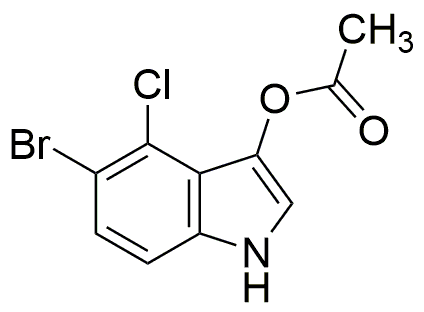5-Bromo-4-chloroindoxyl acetate is widely utilized in research focused on:
- Histochemical Staining: This compound serves as a substrate for the enzyme β-galactosidase, allowing researchers to visualize enzyme activity in tissue samples, which is crucial for understanding various biological processes.
- Biochemical Assays: It is employed in assays to detect and quantify enzyme activity, particularly in studies related to metabolic pathways, aiding in drug development and disease research.
- Plant Research: Used in plant biology, it helps in studying gene expression and the effects of genetic modifications, providing insights into plant development and resistance mechanisms.
- Pharmaceutical Development: The compound's properties make it valuable in the synthesis of new pharmaceuticals, particularly in the development of compounds targeting specific biological pathways.
- Environmental Studies: It can be utilized in assessing the impact of pollutants on biological systems, helping researchers understand environmental toxicity and its effects on ecosystems.
General Information
Properties
Safety and Regulations
Applications
5-Bromo-4-chloroindoxyl acetate is widely utilized in research focused on:
- Histochemical Staining: This compound serves as a substrate for the enzyme β-galactosidase, allowing researchers to visualize enzyme activity in tissue samples, which is crucial for understanding various biological processes.
- Biochemical Assays: It is employed in assays to detect and quantify enzyme activity, particularly in studies related to metabolic pathways, aiding in drug development and disease research.
- Plant Research: Used in plant biology, it helps in studying gene expression and the effects of genetic modifications, providing insights into plant development and resistance mechanisms.
- Pharmaceutical Development: The compound's properties make it valuable in the synthesis of new pharmaceuticals, particularly in the development of compounds targeting specific biological pathways.
- Environmental Studies: It can be utilized in assessing the impact of pollutants on biological systems, helping researchers understand environmental toxicity and its effects on ecosystems.
Documents
Safety Data Sheets (SDS)
The SDS provides comprehensive safety information on handling, storage, and disposal of the product.
Product Specification (PS)
The PS provides a comprehensive breakdown of the product’s properties, including chemical composition, physical state, purity, and storage requirements. It also details acceptable quality ranges and the product's intended applications.
Certificates of Analysis (COA)
Search for Certificates of Analysis (COA) by entering the products Lot Number. Lot and Batch Numbers can be found on a product’s label following the words ‘Lot’ or ‘Batch’.
Numéro de catalogue
Numéro de lot/série
Certificates Of Origin (COO)
This COO confirms the country where the product was manufactured, and also details the materials and components used in it and whether it is derived from natural, synthetic, or other specific sources. This certificate may be required for customs, trade, and regulatory compliance.
Numéro de catalogue
Numéro de lot/série
Safety Data Sheets (SDS)
The SDS provides comprehensive safety information on handling, storage, and disposal of the product.
DownloadProduct Specification (PS)
The PS provides a comprehensive breakdown of the product’s properties, including chemical composition, physical state, purity, and storage requirements. It also details acceptable quality ranges and the product's intended applications.
DownloadCertificates of Analysis (COA)
Search for Certificates of Analysis (COA) by entering the products Lot Number. Lot and Batch Numbers can be found on a product’s label following the words ‘Lot’ or ‘Batch’.
Numéro de catalogue
Numéro de lot/série
Certificates Of Origin (COO)
This COO confirms the country where the product was manufactured, and also details the materials and components used in it and whether it is derived from natural, synthetic, or other specific sources. This certificate may be required for customs, trade, and regulatory compliance.


